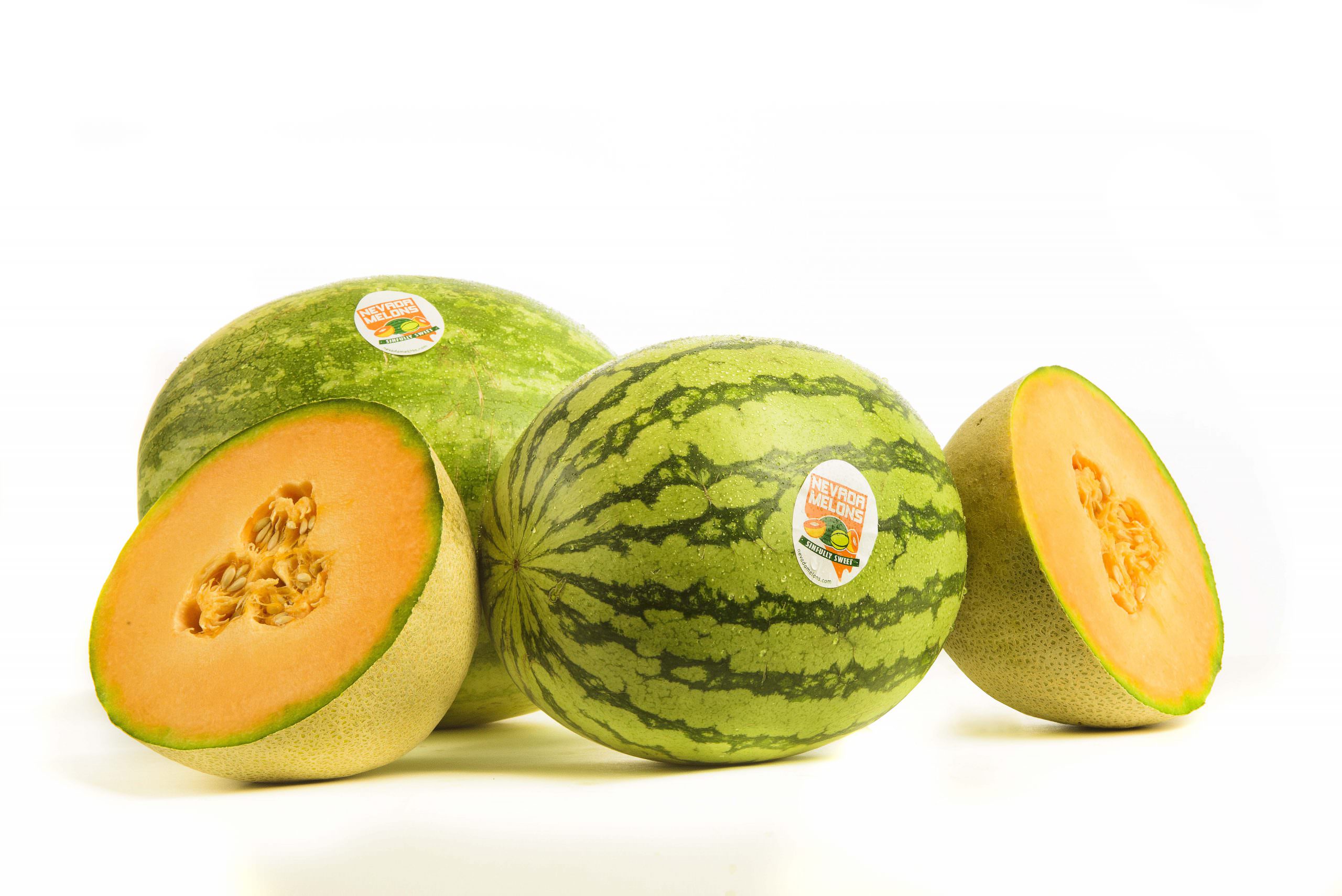With extra warmth and patience, Nevada’s Sinfully Sweet melons can be grown in your backyard.
Round, luscious, and sweet melons are the epitome of summer fruit. However, they are not usually associated with our challenging high desert climate. The vining plant with its balls of golden flesh have actually been grown in the state for more than 100 years and continue to be an important crop. Now they are part of an advertising campaign to affiliate Nevada with some of the sweetest melons you can sink your teeth into.
“When we talk about melons, we are discussing cantaloupes, honeydew, and canary melons,” says Charles Schembre, program manager of the Desert Farming Initiative in Reno. “A watermelon is different and grows differently. It is drought tolerant, but it can be a lot trickier to grow.”
The Desert Farming Initiative is a demonstration, research, and education farming program located at the Nevada Agricultural Experiment Station on the University of Nevada, Reno campus. The DFI began in 2013 and collaborates with the College of Agriculture, Biotechnology, and Natural Resources and the University of Nevada Cooperative Extension. Along with a small commercial farm, the DFI also has an experimental vineyard and farm stand.
“We are supporting the local, sustainable food systems movement and looking at the viability of enhancing local food systems, particularly in the high desert climate,” Schembre says.
Three years ago, the DFI received a specialty crop block grant from the Nevada Department of Agriculture to work with Rick Lattin of Lattin Farms in Fallon and other farmers to brand melons as a unique product of the state. The results are the Sinfully Sweet campaign and a website profiling Nevada’s melon-growing history as well as a list of farms that grow and sell the fragrant fruits.
“Nevada will never produce as many melons as California and Arizona, but Nevada has this history of producing melons,” Schembre says. “The climate is really conducive to growing melons comparable to other crops. With our high heat and high sun, melons are something we can grow here at a high quality.”
In addition to raising awareness of Nevada-grown melons, the DFI team wants to develop a long-term plan to trial different types of melons and see if melons such as the ones that come out of California can be grown in the high desert. Eventually, the DFI will produce a publication for local growers.
“Melons are one of those crops that you don’t need to give constant attention to,” Schembre says. “Winter squash is like that, so are pumpkins, onions, garlic, and potatoes.”
So what’s this farmer’s favorite melon?
“I like a nice cantaloupe or muskmelon,” he says. “They are just so sweet and full of water. You feel you can live off of them if you want.”
Seedy district
For that extra heat beloved by these sugary fruits, Fallon is one of the best places to grow melons. The famously sweet hearts of gold melon has been grown in the valley since 1911, but according to one of the area’s most well-known farmers, it’s not the best melon for a backyard gardener.
“The hearts of gold is one of the most challenging melons to grow,” says Lattin. “It has a long growing season of 90 days, tends to split when ripe, and doesn’t store well.”
The Lattin family has been growing melons in Fallon since 1955. Along with the hearts of gold, the Lattins grow varieties such as divergent, ambrosia, Sarah’s choice, tirreno, and what are known as personal melons, such as sugar cube. Lattin says that the sugar cube is one of the sweetest melons grown on his farm.
“We try to give the community something special that is not available at the supermarket,” Lattin says. “Melons in general are more difficult for the home gardener. In home gardens, they tend to be small and take a long time to mature. Those are the two complaints we get.”
According to Lattin, melons need a rather large area and full sun, and they benefit from being under plastic covers. The melon plants must be watered at the roots and need pollinators to produce fruit. The Lattins actually place beehives owned by Rau Bees in their hoop houses to encourage the bees to pollinate their plants. Melon seeds are forgiving and will germinate in many types of soil, but seedlings are sensitive to wind and should be protected with a cloche and mulch.
The best way to check if a melon is ripe is to lightly pull at the stem. If it easily rips from the fruit, it’s ripe. If it takes some effort, leave it alone for a few more days. Another way to check is to press your finger into the bottom of the fruit; if it gives just a bit, it’s ready to eat.
This summer, if your own melons are taking their sweet time to ripen, head to the Fallon Cantaloupe Festival & Country Fair. Held since 1985, it’s one of Nevada’s longest-running agricultural festivals and will be held the weekend before Labor Day.
“We’re really excited about the event this year,” Lattin says. “If you can’t come to the farm, come to the festival.”
From her Washoe Valley base, Christina Nellemann has never been lucky growing melons. But she’s more than happy to enjoy them at the cantaloupe festival.
For details, visit Nevadamelons.com and Falloncantaloupefestival.com.
Melons for Northern Nevada backyard gardeners
- Sarah’s choice
- Santa Claus (also known as piel de sapo or “toad skin”)
- Korean
- Canary
- Green flesh honeydew
- Orange flesh honeydew
Northern Nevada farmers’ markets for melons
Lattin Farms
- Fernley Farmers’ Market
- Sparks United Methodist Church Farmers’ Market
- East Center Street Farmers’ Market (Fallon)
- The Village Market (Reno)
First Fruits Sustainable Farm
- Riverside Farmers’ Market (Reno)
- Sparks United Methodist Church Farmers’ Market
- The Village Market (Reno)
- Carson Farmers’ Market (Carson City)


